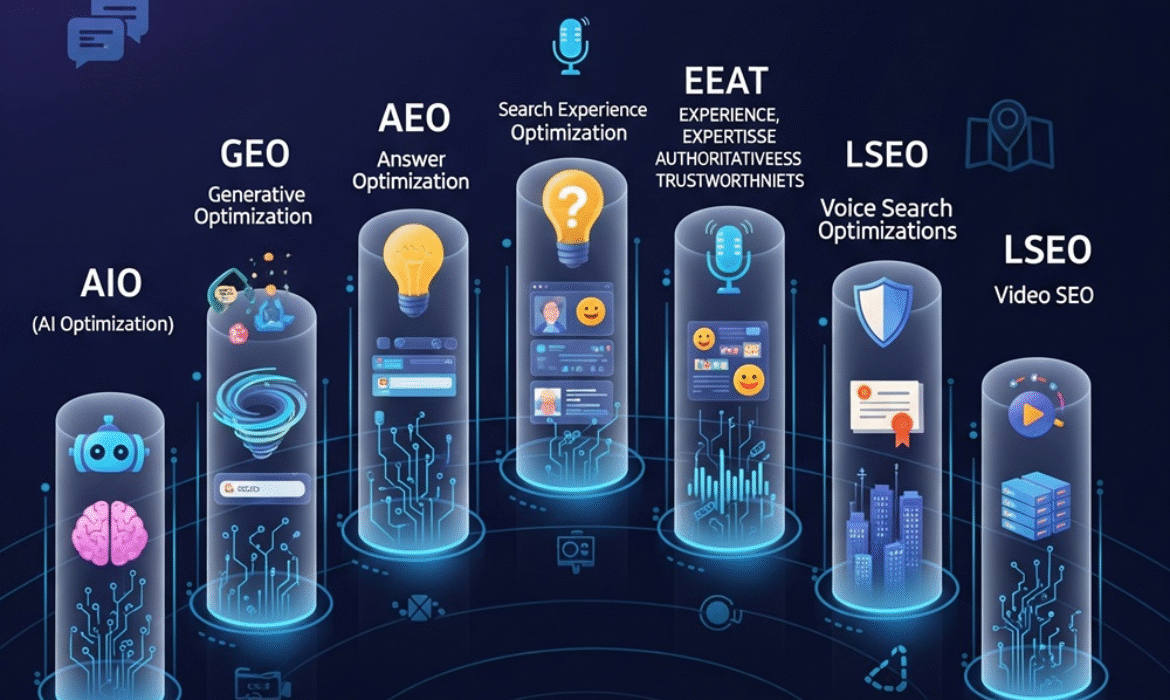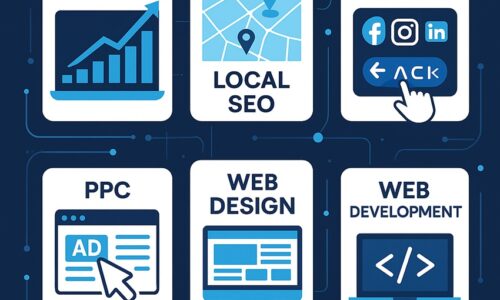Search Engine Optimization (SEO) is no longer what it was even three years ago. The rise of AI-powered search, voice assistants, generative answers, and multi-platform discovery has fundamentally reshaped how businesses gain visibility online.
In 2025, SEO is about much more than keywords and backlinks. It’s about optimizing for AI models, search experiences, video platforms, local intent, and trust signals.
In this guide, we’ll explore the 8 new pillars of SEO in 2025 every marketer needs to master to stay ahead:
- AIO — AI Optimization
- GEO — Generative Engine Optimization
- AEO — Answer Engine Optimization
- SXO — Search Experience Optimization
- VSO — Voice Search Optimization
- EEAT — Experience, Expertise, Authoritativeness, Trustworthiness
- LSEO — Local SEO
- Video SEO
1. AIO — AI Optimization
What It Means
With tools like ChatGPT, Copilot, Perplexity AI, and Gemini being used as alternative search engines, SEO in 2025 isn’t just about Google. Users ask AI models for recommendations, summaries, and buying advice—and these AIs surface content they trust.
How to Optimize
- Structured Content: Use schema markup (FAQs, How-to, Product) so AI models can easily extract context.
- Conversational Style: Write in Q&A or natural formats, as LLMs prefer clear context.
- Source Citations: Publish research, statistics, or unique insights so AI models reference your brand.
Example
Perplexity AI often cites original blogs and data-rich pages over generic content. A SaaS brand publishing detailed “how-to” guides with real metrics saw their site referenced in AI answers, driving brand recognition even without clicks.
👉 Lesson: If AI is a search engine, treat it like one. Make your site readable by AI tools.
2. GEO — Generative Engine Optimization
What It Means
Google’s Search Generative Experience (SGE) is transforming search. Instead of a list of 10 blue links, users get AI-generated summaries at the top. This reduces organic clicks, but opens new visibility opportunities.
How to Optimize
- Answer-first structure: Start with a concise response, then expand with details.
- Topic Clusters: Cover related subtopics in-depth to improve chances of being cited.
- Multimedia Content: Include images, charts, and videos—Google SGE often embeds visual snippets.
Example
A health blog structured its posts with “short answer + detailed breakdown” and saw their summaries featured in Google’s SGE, doubling impressions despite fewer clicks.
👉 Lesson: Don’t just write for readers—write for AI summaries.
3. AEO — Answer Engine Optimization
What It Means
Users are increasingly searching through voice assistants and AI-powered Q&A. Answer Engine Optimization ensures your content provides direct, clear answers to common questions.
How to Optimize
- FAQ sections with structured data.
- Concise definitions at the top of articles.
- Question-based headings (H2/H3s like “What is AIO in SEO?”).
Example
Websites with FAQ schema are 3x more likely to appear in featured snippets or voice search results.
👉 Lesson: If you don’t answer directly, your competitors will.
4. SXO — Search Experience Optimization
What It Means
Google rewards not just clicks, but positive user experience. SXO blends SEO with UX (User Experience), focusing on how users feel once they land on your page.
How to Optimize
- Fast Loading: Core Web Vitals still matter—slow sites drop rankings.
- Clarity: Use clean design, bullet points, and scannable text.
- Interactivity: Add tools like calculators, quizzes, or interactive visuals.
Example
A fintech startup improved page load time by 40% and redesigned their blog for readability. Result: 25% longer session duration and higher rankings.
👉 Lesson: SEO is no longer just about getting visitors—it’s about keeping them engaged.
5. VSO — Voice Search Optimization
What It Means
By 2025, over 50% of searches are conversational or voice-based. Optimizing for voice search means writing content the way people speak.
How to Optimize
- Target long-tail, natural questions (“What’s the best CRM for freelancers in 2025?”).
- Use conversational tone instead of jargon.
- Optimize for local queries (e.g., “Best Italian restaurant near me open now”).
Example
A restaurant optimized its Google Business Profile and added conversational Q&A. Within 3 months, they ranked #1 for “best pizza near me” voice searches in their city.
👉 Lesson: If people can say it, your content should answer it.
6. EEAT — Experience, Expertise, Authoritativeness, Trustworthiness
What It Means
Google emphasizes trust and credibility as ranking factors. AI tools also prefer citing authoritative content over generic AI-generated text.
How to Optimize
- Add author bios with credentials.
- Publish case studies, testimonials, and original research.
- Get backlinks from reputable sources.
Example
A financial services company added certified author bios and first-hand case studies to its blog. Rankings improved significantly for high-competition keywords.
👉 Lesson: In the age of AI, trust is your biggest SEO asset.
7. LSEO — Local SEO
What It Means
Local intent remains powerful. People rely on “near me” searches and maps to discover businesses.
How to Optimize
- Claim and optimize your Google Business Profile.
- Add local keywords in titles, meta, and content.
- Encourage reviews and ratings.
Example
A dental clinic optimized their GBP with services, FAQs, and weekly posts. They ranked in the top 3 local pack for “dentist near me” within 2 months.
👉 Lesson: Local SEO drives revenue for small and mid-sized businesses in 2025.
8. Video SEO
What It Means
Search is shifting from text to video-first platforms like YouTube, TikTok, and Instagram. These platforms are search engines themselves.
How to Optimize
- Use keyword-rich titles and descriptions.
- Add captions, transcripts, and chapters.
- Repurpose blogs into videos for double visibility.
Example
A fitness influencer turned blog guides into short TikToks with SEO-rich captions. Within 6 months, they ranked for multiple search terms on TikTok AND Google.
👉 Lesson: Video is no longer optional—it’s a pillar of SEO.
🔮 The Future of SEO in 2025
SEO in 2025 is multi-channel and AI-first. Success isn’t just ranking on Google but being discoverable across:
- AI assistants (ChatGPT, Perplexity, Copilot)
- Generative engines (Google SGE, Bing AI)
- Voice search (Siri, Alexa, Google Assistant)
- Local maps
- Video platforms
The SEO winners of 2025 will:
✅ Optimize for AI tools (AIO & GEO).
✅ Deliver short, direct answers (AEO & VSO).
✅ Prioritize user experience and trust (SXO & EEAT).
✅ Dominate local and video search (LSEO & Video SEO).
✅ Action Plan for Marketers
- Audit your content for AI readiness and structured data.
- Rewrite blogs into answer-first, conversational style.
- Invest in author authority, case studies, and original data.
- Build interactive, fast-loading sites with better UX.
- Expand into video platforms with keyword-rich optimization.
- Claim local listings and encourage reviews.
Conclusion
SEO in 2025 isn’t dying—it’s evolving. The old playbook of keywords and backlinks isn’t enough. To stay ahead, brands must embrace AI-first, user-first, and multi-platform strategies.
👉 Are you ready for the future of SEO? How are you adapting your strategy to these 8 pillars?
📌 Download our free SEO 2025 Checklist to start implementing these changes today.






